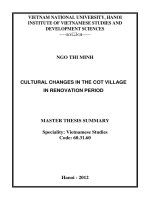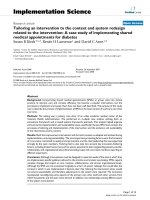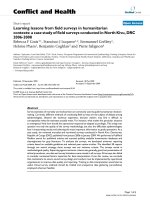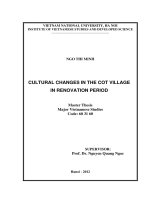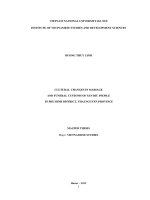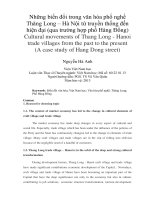Cultural movements of Thang Long - Hanoi trade villages from the past to the present (A case study of Hang Dong street) = Sự biến đổi văn hóa phố nghề Thăng Lon
Bạn đang xem bản rút gọn của tài liệu. Xem và tải ngay bản đầy đủ của tài liệu tại đây (6.67 MB, 137 trang )
VIETNAM NATIONAL UNIVERSITY, HANOI
INSTITUTE OF VIETNAMESE STUDIES AND DEVELOPMENT SCIENCES
NGUYEN HA ANH
CULTURAL MOVEMENTS OF THANG LONG –HANOI
TRADE VILLAGES FROM THE PAST TO THE PRESENT
(A CASE STUDY OF HANG DONG STREET)
MASTER THESIS
Major : Vietnamese Studies
HANOI – 2013
2
VIETNAM NATIONAL UNIVERSITY, HANOI
INSTITUTE OF VIETNAMESE STUDIES AND DEVELOPMENT SCIENCES
NGUYEN HA ANH
CULTURAL MOVEMENTS OF THANG LONG – HANOI
TRADE VILLAGES FROM THE PAST TO THE PRESENT
(A CASE STUDY OF HANG DONG STREET)
Master thesis of Vietnamese Studies
Code : 60 22 01 13
Thesis supervisor: ASSOC.PROF.DR. VU VAN QUAN
HANOI – 2013
3
TABLE OF CONTENTS
COMMITMENTS
INTRODUCTIONS……………………………………………………….1
1. Reason for choosing topic…………………………………………… 1
2. Story of research the topic ………………………………………… 2
3. Research objectives…………………………………………………….7
4. Subjects and research scope………………………………………… 7
5. Research method……………………………………………………….9
6. Contribution of the thesis…………………………………………….12
7. Structure of the theisis……………………………………………… 13
Chapter 1: THEORETICAL FRAMEWORK AND OVERVIEW OF
HANGDONG STREET……………………………………………… 14
1.1. Theoretical frame work…………………………………………….14
1.1.1. Craft village and trade village…………………………………… 14
1.1.2. Culture change of trade village ………………………………… 21
1.2. Overview of Hang Dong ……………………………………………26
1.2.1.Geographical location …………………………………………… 26
1.2.2. Population components and process of inhabitance………………27
Chapter 2: CHANGE OF ELEMENTS IN CULTURE OF HANG
DONG TRADE VILLAGE FROM THE PAST TO THE
PRESENT……………………………………………………………… 40
4
2.1. Community relationship……………………………………………40
2.1.1. Limited theory of definition………………………………………40
2.1.2. Indication………………………………………………………… 40
2.2. Architecture space……………………………………………… 47
2.2.1. Formation of production and business architecture space of the old
quarters………………………………………………………………… 48
2.2.2. Changes to architecture spaces in production and business in Hang
Dong Street……………………………………………………………… 51
2.3. Lanscape…………………………………………………………….64
2.3.1. Prior to 1986……………………………………………………… 64
2.3.2. Since 1986 to now…………………………………………………64
2.4. Production activities ………………………………………………68
2.4.1. Production and labor structure……………………………………68
2.4.2.
Products………………………………………………………………… 69
2.5. Business activities……………………………………………… 75
2.5.1. General business activities…………………………………………75
2.5.2. Business activities of traditional copper products…………………79
Chapter 3: SOME RECOMMENDATIONS FOR
RESERVATION AND DEVELOPMENT OF CULTURE OF
HANG DONG STREET………………………………………… 84
3.1. The significance of reservation of culture in trade village……….84
5
3. 2. Foundation of recommendations………………………………….84
3.2.1. Theoretical foundation……………………………………………84
3.2.2. Assessment of Hang Dong street face……………………………86
3.3. Some specific recommendations……………………………………88
3.3.1. Development of products………………………………………… 88
3.3.2. Human resources development…………………………………….90
3.3.3. Recovery of copper craft village in Hang Dong street…………….92
3.3.4. Combination of tourism through street: From trade village to caft
village…………………………………………………………………… 92
CONCLUSION……………………………………………… 98
REFERENCES……………………………………………….104
APPENDIXES
6
INTRODUCTION
1. Reason for choosing topic
1.1. The context of market economy has led to the change in cultural
elements of handicraft village and trade village
The market economy has made deep changes in every aspect of
cultural and social life. Especially, trade village which has been under the
influence of the policies of the Party and the State has continuously
changed, led to the change in elements of trade village. Many craft villages
and trade villages are in the risk of falling into oblivion because of the
negligible need of a handful of customers. The artisans in craft villages and
trade villages must change some steps of production process, type of
products, models, function to adjust to the market‟s need and the
development of socialist-oriented market economy for survival. As a result,
the culture of craft village and trade village also has transformed with the
various scale and speed depending on the economic conditions of every
village or street. This transformation happens following two ways:
adjusting or conservation.
1.2. Thang Long trade village – Hanoi is in the orbit of the deep and
strong cultural transformation
For hundreds of years now, Thang Long - Hanoi craft village and
trade village has been our pride with significant contribution to the
development of the Capital. During development history, Thang Long -
Hanoi craft village and trade village have made significant contributions
economic development of the Capital. Thanks to the trade villages that both
produced and traded, they fostered the growth of economy in Thang Long
especially the commodity economy. This economic development in Thang
Long was the basis of house and street planning at that time. Nowadays,
7
craft village and trade village of Hanoi have been becoming an important
part of the Capital that have the deep significance not only in the economy
but also in culture, contributing to job solutions, economic structure
transformation, tourism development, enhancement of living standards both
in rural and urban areas, stabilizing and developing new countryside.
In the context of strong transformation in economy, politics, culture and
society today, the research of craft village and trade village becomes more
and more imperative in order to conserve and bring into play the traditional
values of Thang Long - Ke Cho region.
1.3. Research about Hang Dong street ( in Thang Long – Hanoi trade
village) indicates that new surface is associated with the context. The way
of approach of the cultural transformation connected to the features of
trade village is a practical research way
Hang Dong street is in Hanoi Old Quarters. As one of six remaining
trade villages of former Ke Cho region, Hang Dong street has traded
copper products for years. Now, there are only some families involved in
copper hammering that is a scarce industry that still bears the features of
former Ke Cho region. Here was the residence of people of Dai Bai copper
hammering and carving village, in Gia Binh district, Bac Ninh province
and the traders of copper products of Cau Nom village, Khoai Chau
district, Hung Yen province as well as other immigrants from some else
areas. The copper industry has strongly changed over time. Because of the
change of this trade village, cultural managers need to research, find out
and draw up specific policies to preserve and conserve nice traditional
values of trade village.
2. History of research the topic
8
When studying documents related to topic “The cultural
transformationof Thang Long – Hanoi trade village since 1986 to now
(research about Hang Dong street case)”, we divide previous research
works into three groups:
2.1. Research works about Thang Long – Hanoi craft village and trade
village
2.1.1. Current situation of craft village, trade village
The surface of craft village and trade village may not be a new issue.
Until now, there have been plenty of research works about this issue. The
work “Thang Long - Hanoi craft village and trade village in the
developing path” [47] is typical. This work edited by Vu Quoc
Tuan generalized chronologically the development of craft village and
trade village , from the feudal period (1010-1858), going through the
French domination period and the resistance against the French colonialists
(1858-1954), from the period of liberated Hanoi to the national unity period
(1955-1975), after great victory in spring 1975 to 1986 and from the
innovation period of 1986 and later to the expansion of Hanoi‟s area.
During all that time, Thang Long – Ha Noi craft village and trade village
constantly grew through many stages, particularly in the years when our
Party defined the policies of innovation to bring a new lease of life to the
conservation and development work of craft village and trade village. The
handicrafts of craft village and trade village not only play an important role
in economy such as meeting the domestic need and exporting but also bear
the traditional values of culture that have been kept through many
generations of artisans, as well as have been developed by modern
technology in present international integration time” [47; 7]. In current
stage, the author mostly focuses on achievements and shortcomings of
current craft village and trade village. From that point, the author forecasts
9
the trend of development of Hanoi craft village and trade village. “Going
into new industrialization - modernization and international integration
stage of the capital with many opportunities as well as challenges, the duty
of conservation and development of craft village and trade village struggles
with numerous difficulties and needs to be promptly solved. A lot of
difficulties with which the craft villages are dealing with are: unexpanded
market, tough competition, not-innovative models, scanty land for
producing and trading, polluted environment, slowly improved skills of
labor force, poor management skill of owners, bad treatment to artisans,
limitation in application of science-technology to production of craft
village,… Overcoming those obstacles and weaknesses involves a deeper
awareness of great values of craft village together with an actual change in
direction of all levels of capital authorities including apparatus and
officials ” [47; 213-214].
In the same approach, the work “Thang Long – Hanoi craft village,
trade village” of authors Tran Quoc Vuong and Do Thi Hao [49] summed
up the surface of Thang Long – Hanoi craft village, trade village. Notably,
this work listed all the industries of craft villages and trade villages in
Thang Long, Hanoi. In particular, there are seven craft villages: Bat Trang
pottery village, Dinh Cong gold and silver village, Thiet Ung wood
sculpture village, Ngu Xa copper cast village, Trieu Khuc embroidery
village, Linh Buoi waving village, Yen Hoa and Ke Buoi paper villages
and six trade villages: Hang Trong painting street (or Hang Tranh –
Painting Street) and Hang Trong painting collection, Hang Theu street and
Quat Dong embroidery, Tho Tien street and lathing in Nhi Khe , Hang
Khay street and Chuyen My nacre inlaying, Hang Bua street with Hoe
Thi forge, Hang Dong street and Dai Bai copper hammering.
10
2.1.2. In terms of craft village, trade village management, we can
mention the work “Craft village in national development” of Vu Quoc
Tuan [46]. This work focused on the way to manage craft village,
consisting of selected articles about craft village in many writings and
topics that were published or stated in recent seminars of author and the
articles related to economic regulation and administrative reform such as
“Modeling of handicrafts to craft village” [46; 123-132], “Association to
exist and develop” [46; 133-136] or “Co-operative with improvement of
cooperative relationship in craft village” [46; 137-142]. In the direction of
craft village growth, the author wrote a whole chapter for “building up
skilled labor force” [46; 171-234] and “innovating institution and policies
of management” [46; 241-374].
2.2. Research works about the transformation in culture of craft
village, trade village
As regard to research of transformation in culture of craft village,
trade village, we could refer to following typical works: Cultural
transformation in Red River delta from 1986 to the present (By
surveying some cases in certain villages: Son Dong (Ha Tay), Bat
Trang (Hanoi), Dong Xam (Thai Binh)) of author Vu Dieu Trung [43].
This dissertation researched comprehensively and completely about the
cultural transformation of craft village and focused on researching three
craft villages including Son Dong (Ha Tay), Bat Trang (Hanoi), Dong Xam
(Thai Binh) and extra research of 61 craft villages in three districts
including Hoai Duc, Gia Lam, Kien Xuong to indicate general cultural
transformation in craft villages. In terms of cultural transformation, the
author chose to research from 1986 attached to the Sixth Assembly of
Vietnamese Communist Party [43]. The author analyzed elements of
transformation such as: transformation of space, landscape and relics;
11
transformation of production organization mode and production technique;
transformation of knowhow; transformation of social relationship and
conception; transformation of beliefs, festivals, habits and customs. In the
process of adapting to market economy, mode of production, technology of
manipulation and products of craft village have been modified to adjust to
market‟s need. The new guilds with new functions have appeared instead
of handmade guilds. Craftsmen have applied machines to production and
associated with others to establish production groups or companies…” [43;
112].
2.3. Research works about Hang Dong street and Dai Bai copper
hammering village
Hang Dong street and Dai Bai copper hammering village is a rather
new subject. Up to now, there has been only one work that did research on
Dai Bai copper hammering village, it is the book Dai Bai copper
hammering village, Do Thi Hao, Vietnam Folk Art Performance
Association, 1987 [13] and the book Thang Long – Hanoi craft village,
trade village, Vietnam Folk Art Performance Association, Tran Quoc
Vuong, Do Thi Hao [49]. The appendix at pages 429-430 only recorded
the title conferment to progenitor Nguyen Cong Truyen in the 7
th
Duy Tan
period (1913).
Dai Bai copper hammering village is probably the only work that
studied Dai Bai copper hammering. This work includes 93 pages involved
the appendix, generalized the surface of Dai Bai village, from location,
formation history to the preserved cultural traditions in localities [13; 7-37].
Especially, the author spent almost the book to describe the copper
hammering tradition by the stories about the progenitor, materials,
production process [13; 39-67]. From page 67 to page 93 of this work, the
12
author added an appendix to describe the copper hammering industry. This
is the important documentation for the thesis to draw on it.
Up to now, there has never been any work that studied Hang Dong
street. The only reference material is on the internet but not much.
Therefore, the topic “Cultural transformation of Thang Long – Hanoi
trade village From 1986 to the present” (the case study of Hang Dong
street) has still not been referred to by any work before. In the face of many
problems such as the less passionate artisans as well as the imported
products from China or Thailand, we need to learn and outline the surface
of transformation, then propose the solutions to preserve and promote value
of unique products of trade village. As a result, the implementation of this
topic is not only theoretic but also practical.
3. Research objectives
Carrying out this topic, the author aims at following objectives:
Firstly, to outline the surface of Hang Dong street from location,
population components and origin to economic life of the trade village.
Secondly, to indicate typical transformation of each element in trade
village, thence show how features of trade village lead to clear
transformation. This is the crucial objective of the topic. From this
transformation, the thesis explains, evaluates and proposes solutions to the
re-planning of the street in such a way that the living, production and
trading activities could develop under the most favorable conditions.
4. Subjects and research scope
4.1. Subject
13
The thesis concentrates research about clutural movements of Hang
Dong street, from the past to the present.
4.2. Research scope
Research space:
The scope of research is Hang Dong street including 48 households.
The interviewed people are selected randomly from the age of 23 to 83.
They are almost married and has been living and trading here. They are
illiterate or university graduates. They are from all walks of life: farmer,
worker, teacher, officer, small trader, retiree or freelancer… and have lived
both inside and outside of Hang Dong street.
Research duration
The landmark of research of transformation is 1986. The reason is
that prior to 1986, Vietnam economy was subsidized by the government
from central level to local level. The economic system which was based on
administrative subsidies had been lasted too long and was not suitable to
the period from 1986 when Vietnam began to effectuate the innovation
policies from centrally-planned economy to market economy, develop the
multi-sector economy in which individual economy sector played a more
and more important role, proactively and effectively integrated national
economy into regional and world economy in accordance with real
conditions of Vietnam. From 1986 and later, owing to the policies of open
economy and stimulating trade, Hang Dong street in particular and Hanoi
in general have developed strongly trading activities. The massive
immigration from contiguous provinces to Hanoi, the appearance of shops
and the diversification of mode of trading have made the clear change of
the surface of Hang Dong street.
14
There is one more important event in 1986. That is the change of
State policy in worshipping products. After national unity period from 1975
to 1986, the Party put forward the policy to abolish superstitions.
Therefore, the production of worshipping products was considered as direct
supporting activities for superstitions. During 10 years, the craft villages
and trade villages which produced worshipping products had no consuming
market. As a result, the production was discontinued, led to the decrease in
income of handicraft families. After 1986, the change in policy of the Party
was really a stimulation to strong development again in scale of Hang
Dong trade village.
From 1986 to the present, we emphasize the research landmark since
2000. The reason is from 2000 to now, the urbanization with deep
transformation in economy, culture and society has impacted this trade
village. Urbanization process has had both positive and negative effects on
every aspect of economic, cultural and social life. Urbanization has caused
the growth of population, brought about the increase of need and benefits
towards the relic area. This increase has both positive and negative
indications.
In terms of need, urbanization enhances living standard of people.
Thishas brought about the increase in inevitable need of housing and living.
Besides, the need of trading has made people to extend space for business.
These needs have led to rapid increase of invasion to public space for
business purposes.
In terms of benefits, urbanization makes change in people‟s mind.
Immediate benefits make some people absorbed in trading but forget to
protect this important relic. This causes serious consequences like damaged
landscape
15
5. Research method
Four following methods are used associatively in the topic.
5.1. Observation method
Due to a pretty small and concentrating street, we can easily perform
this method. The observation method is used to learn about architecture and
landscape of Hang Dong street. To analyze community relations in the
street more deeply, we attend and observe a meeting of the residential
group there.
5.2. In-depth interview method
This is main method used in the topic. Subjects of the interview
include citizens in Hang Dong street and Dai Bai village with questions as
follow.
5.2.1. Hang Dong street
(1) Residential group leader of Hang Dong street, Hang Bo ward, Hoan Kiem
district – Mr. Phung Manh Tuong, living in No.36 Hang Dong street
- Management of population according to family records in the street
- Difficulties in management of households
- Name, native village of householder
- History of formation and development of the street
- Change of landscape and architecture over time
- What to propose for street space planning for the sustainable
development of trade village
16
(2) Hanoi natives living in Hang Dong street: Mr. Tran Thien Can, No. 38
Hang Dong street, his family of four generations living in the old quarters.
- Family annals include name, birthplace, career of husband, wife
and children
- Habits and custom of the family
- General activities of the street
- Divergences in family and street? Their causes
- Thought on people from other place living, doing business and
permanent settling there
- Proposal to street landscape planning for living and trading
(3) Native people in Dai Bai, Bac Ninh is living in Hang Dong and Dai Bai
*Mr. Tran Dai Nghia, free merchant in No. 27 in Hang Dong
- Family annals include name, birthplace, career of husband, wife
and children
- General activities of the street
- Habits and customs of family
- Festival: Do they come back to participate? How is there
contribution? What do they think about festival?
- The divergences in family and street? Their causes
- Thoughts on living, doing business and permanent settling in the
street
- Proposal to street landscape planning for living and trading
17
* Mrs. Ho Thi Duc, No.10 – Thanh Loc shop
- The number of generations in her family working in handicraft
- Comparison of manufacturing and business activities at home to
those in Hang Dong
- The advantages and difficulties in developing the production and
business activities
- How many employees her family have, How much is their salary.
- Vocational orientation for children
- Environmental pollution in Hang Dong street due to production
- Needs and tastes of customers
5.2.2. Dai Bai village
(1) Nguyen Van Chien, Nhung Chien shop, Son hamlet, Dai Bai
village, Gia Binh district, Bac Ninh province
- The number of generations in her family working in handicraft
- Comparison of manufacturing and business activities at home to
those in Hang Dong
- The advantages and difficulties in developing the production and
business activities
- How many employees her family have, How much is their salary.
- Vocational orientation for children
- Environmental pollution in Hang Dong street due to production
- Needs and tastes of customers
18
(2) Mr. Nguyen Van An - vice manager of Dai Bai relics
management board
Mr. Nguyen Van Tinh – staff of Dai Bai relics management board
- The migration from the Dai Bai village to Hang Dong street
- Awareness and participation of Dai Bai people living in Hang Dong
street in the activities and festivities of Thanh (saint) and anniversary of
casting ancestor
Documents about Hang Dong street before 1986 are explored by
collecting old sources and especially interviewing with retrospective
documentary.
This method aims to study the characteristics of the research
subjects, objectively identify the contributions and limitations of the
subjects and then take the most scientific and effective measures for
problem solving. (Form is presented in Appendix).
5.3. Method of questionnaire, survey
This method is used to collect the most updated data on the
economic, cultural, social situations and especially those related to the
community, such as population, occupation, income and current education
level, etc. In terms of investigation method, we gave the form “Survey
sheet of culture life in Hang Dong street” to the residential groups leaders
in Hang Dong street. In terms of survey method, we conducted a survey of
landscape space and activities of business and sales of the old town to find
out what the general features of this street are.
Besides, in order to better assess the changes in the business
activities, we did a survey form “Survey of copper business activities in
Hang Dong street” and gave randomly to 30 people manufacturing and
19
trading copper (Form is presented in Appendix).
5.4. Method of studying documents, method of collecting and classifying
documents
We carried out research and overview statistics of documents on
such subject. However, being a fairly narrow subject, the data source of
this street is pretty little, mostly overviews about Thang Long – Ha Noi.
6. Contribution of the thesis
Conducting this topic, the thesis contributes on the following aspects
Firstly, it outlines the looks of Hang Dong street from location,
composition and population origin to the economic life of trade village.
These are important documents in the process of management of trade
village for managers.
Secondly, it indicates the changes in characteristics of each element
in trade village, indicating how the nature of “trade village” clearly defines
the changes. This is the greatest result of the topic.
Thirdly, Hang Dong street planning aims to associate economic
development with traditional crafts, travel from Hang Dong trade village to
Dai Bai craft village.
7. Structure of the thesis
Apart from the Introduction, Conclusion and Appendixes, the
content of the thesis consists of three chapters
Chapter 1. Theoretical foundation and overview of Hang Dong street
Chapter 2. Change of elements in culture of Hang Dong trade village from
the past to the present
20
Chapter 3. Reservation and development of culture of Hang Dong street
21
Chapter 1: THEORETICAL FRAMEWORK AND OVERVIEW OF
HANG DONG STREET
1.1. Theoretical framework
1.1.1. Craft village and trade village
1.1.1.1. Traditional handicraft
On the concept of "traditional handicraft ", author Vu Quoc Tuan
stated that: "Traditional handicraft is considered as small scale industry
specializing in production by hand with simple tools, primarily using
manpower with the creative experience of the artist and skilled workforce”
[46;10-12].
From this concept, we can see that a job is considered traditional
handicraft must include three elements: 1) Technical skills and experience
of craftsmen and skilled workforce. 2) Traditional tools. 3) Processing of
natural available materials on-site.
According to authors Vu Quoc Tuan for the formation of traditional
handicraft, Vietnam traditional handicrafts are generally determined based
on the following factors: 1) Formation, existence and development in our
country for a long time. 2) Concentrated production that forms the craft
village and trade village. 3) With several generations of talented artisans
and a team of skilled craftsmen. 4) With stable traditional techniques and
technologies. 5) Use of local materials mainly in the country. 6) Typical
22
unique, economic products with high cultural value. 7) As a profession that
feeds and supports a part of or whole community of one or several villages,
communes, population groups, trade villages.
In the Convention for the Safeguarding of the In- tangible Cultural
Heritage published in 2003, United Nations Educational, Scientific and
Cultural Organization (UNESCO) clearly stated that “The traditional
handicraft is one kind of the intangible culture”. It is the skills and
knowledge necessary to serve the continuous production of handicraft of all
kinds, along with teaching skills and knowledge from skilled workers to
others and making the fine art handicrafts and many other products [46; 10-
12].
1.1.1.2. Village and street
a. Village
“Village”, as many scholars confirmed, is absolutely Vietnamese
word. Unlikely, commune and village are Chinese – Vietnamese words,
village is rooted in Vietnam life and expressed in Vietnamese language
only. This term reflects the existence of "a kind of community together on
the basis of a geographical area with its separate members. These members
are assigned their roles as citizens, locals or residents, having kinship far or
near with other people in village” [30]. The community has its own way of
life, with an economy of agriculture and handicrafts, distinctive features of
psychology, morality and tradition compared to other communities.
b. Street
“Street” means “the place of business” originally and shop currently.
However, “streets” locate closely together into a long row so a long row of
“streets” is called “street”. Gradually over time, the word "street" with
23
meaning of "a row of shops" became overwhelmed from "street" of a shop,
a store. Therefore, nowadays we have 36 streets of Hanoi with Hang Bac,
Hang Manh, Hang Dong and so on to mean a series of "street" (shops)
selling the same items.
c. Differences between village and street
Thus, the similarities of "village" and "city" are densely populated
places with particular characteristics of production, business, lifestyle,
customs and habits. However, the difference is the main economic activity
of village with farming and small- industries and of the street with mainly
trade or business. This difference will prescribe the particular
characteristics between the craft villages and the trade village.
1.1.1.3. Craft village and trade village
a. Craft village
From the administrative unit of village, many activities, cultural
features and handicrafts were born. Since Vietnam Village associates with
agricultural areas and seasonal characteristics, many handicrafts were born.
Initially, the craft was only to serve the people in the village; gradually,
with excessive product, they exchanged with another villages; from which
the form of exchange and trade in products was formed, then the traditional
handicrafts developed no less than farming. Trade activities between the
villages of long distance is mainly in waterways due to topographical
features of Vietnam. There are three basic factors leading to the formation
of the craft villages in the Vietnamese agricultural village, which are: (1)
human resources (take advantage of the leisure time after harvest), (2)
source of available raw material, (3) favorable waterway. Each village
could have one or more than one crafts. The crafts were the handicraft
industries that were formed, existed and developed in a long time of
24
history; the production concentrated in one certain area or village, then
formed the craft villages. The basic features of a traditional craft were
traditional techniques and technologies as well as the team of artisans and
craftsmen. The products must be full of characteristics of goods, artistry
and imbued with national characters.
On the concept of craft villages, authors Vu Quoc Tuan said that
“Traditional craft villages are a live economic, social and cultural entity,
existing and pretty sustainably developing in one or more crafts of long-
standing tradition. There, it could be that all or most of the people in the
village work in traditional handicraft, or a part of them engage in
production and trade of handicrafts. The village is the place gathering
results of craft maintaining and developing process” [46; 10-12].
From the above concepts, it finds that traditional craft village is the
center of production, processing and sales of handicrafts; the place to
gather artisans and skilled craftsmen from families, family lines, clans that
have existed, developed and been well-known for a long time. There,
people work according to guild style, every craftsmen must comply with
the tight provisions. People worship the same craft ancestor.
In formation history, the craft village was formed by many different
ways:
(1) Traditional village first, then handicraft, taught by craft
ancestor
(2) Several people knowing craft set place of private production
and residence as camp-style.
Traditional craft villages usually need typical characteristics like 1)
long standing. 2) With craft ancestor. 3) With artisans. 4) Long stable
25
traditional technologies. 5) Ability to maintain and develop by imparting.
6) The stable unique product with economic, cultural, social meaning, with
market.
b. Trade village
According to author Vu Quoc Tuan “Trade village is urban street
specialized in manufacture and trade of one more products of traditional
handicraft; place to gather artisans, craftsmen (local people or from other
places); they worship a same common craft ancestor as in father land and
work together in a social and professional organization of guild type” [46;
10-12].
In the trade village, people still keep lifestyle, habits and customs as
village style, craftsmen come from farmers or work in both handicraft and
farming in their native village. However, due to the lifestyle of urban
residents, the craftsmen at the trade village have the elegant styles of
townspeople. In each street, the union of craftsmen went to reside,
wholesale or do seasonal work in Thang Long. As legend of Hang Trong
street (Drum street), it was allowed by King Ly Cong Uan to move from
Thanh Hoa to Thang Long for doing busines. This award originated from
reason that people of Doi Tam village (Thanh Hoa) brought their drum to
beat and celebrate the event that King Ly Cong Uan moved the capital to
Thang Long. They gradually settled there, one after another, gathered at a
part of precinct, stayed closely together in a street to make handicrafts, do
business and live. Since it appeared, trade village has changed in several
things along with history changes. Some trade villages have been existed,
strong developed, also expanded and spread to surrounding area. Besides,
some streets are operating moderately, unstably; even some tend to be in
oblivion, into decadence and vanish in thin air. Therefore, learning about
the cultural movements of trade village is extremely important in the

